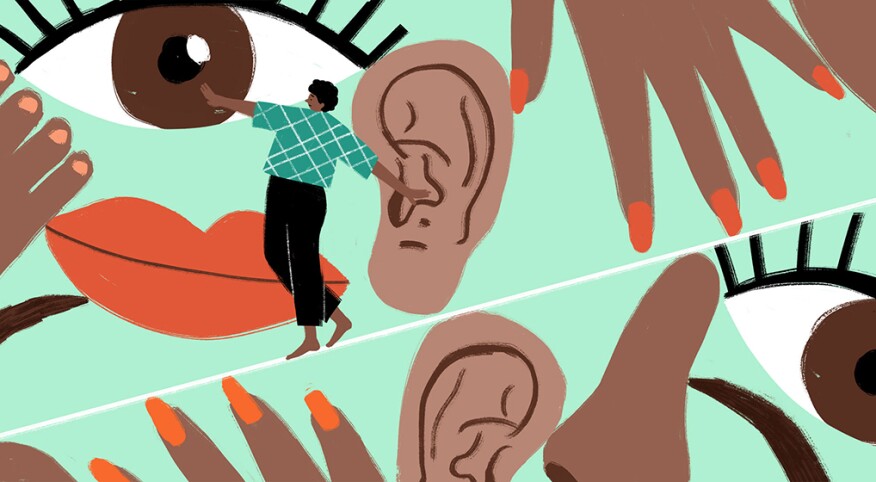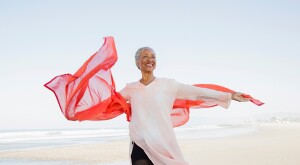Do you ever think about the dope things our bodies automatically do for us daily? Neither did I — until crystals in my inner ear were somehow knocked out of whack. I rose from a chair and tumbled over into the file cabinet. That case of vertigo had me missing chairs and falling on my behind for three months!
That was the last time I took my sense of balance for granted. Complex systems engage our ears, eyes, brain, joints and muscles in the process of sensing and then communicating information to the brain about our location in space, our surroundings and our movements and actions. For example, because the inner ear has nerves and structures that help us to keep our balance, an ear infection can make us feel dizzy or unsteady. As we get older, we naturally lose some proprioception — our awareness of the position and movement of our bodies. (An example of proprioception in action is knowing when your feet have stepped from a hard wood floor to soft carpeting without looking.)
However, feeling unsteady isn’t always a factor of aging. If you’re sitting too much, without enough physical activity, your legs, lower back and glutes become weaker, affecting balance. That’s a concern for anyone who’s homebound now due to the pandemic.
Have you noticed that lately you might be having a little trouble standing on one leg as you try to put on a pair of pants, and you have to sit down? Do you struggle when walking in a dark room? Do you feel clumsier than before? Even if the answer to each of these is no, the time to take steps to preserve or improve your balance is now. First, make balance training part of your fitness regimen, with your doctor’s OK. Second, continue to discuss any changes in balance or related symptoms with your doctor.
Feeling unsteady isn’t always a factor of aging. If you’re sitting too much, without enough physical activity, your legs, lower back and glutes become weaker, affecting balance. That’s a concern for anyone who’s homebound now due to the pandemic
“A critical part of keeping … balance in our lives is staying active,” according to Catherine Alicia Georges, professor and chair of the Department of Nursing at Lehman College of the City University of New York, who has also served as AARP’s national volunteer president.
Great exercises to support balance
According to the National Council on Aging, “Most people tend to focus on one type of exercise or activity and think they’re doing enough. Research has shown that it’s important to get all four types of exercise: endurance, strength, balance and flexibility. Each one has different benefits. Doing one kind also can improve your ability to do the others, and variety helps reduce boredom and risk of injury.” Balance training helps with coordination, as well as joint stability in knees, ankles and hips, to help with ease of movement and reaction time. You’ll want to incorporate activities that improve leg, muscle and core strength, too. Some options:
- Doing weight, strength and core training will help you improve muscle strength, stabilize how your body moves and keep you steady.
- Tai chi, qigong and yoga can also help with coordination and balance, as well as flexibility.
- A Bosu balance trainer provides an unstable surface that can help you improve core strength and balance.
- If you do seated exercises, ask your doctor about changing from a chair to a stability ball.
- Aquacise in a pool is a safe way to do balance exercises, such as side stepping, walking backwards and one-leg balance, and is also good for reducing arthritis and joint pain.
5 balance exercises to try at home
Feeling a little shaky during a new exercise may be normal, but if you feel like you’re going to fall when you exercise, stop and consult your doctor.
1. Stand on one leg for 10 seconds. Repeat 10 to 15 times and then switch to the other leg. When you get more comfortable, try it with your eyes closed. You can practice standing on one leg while brushing your teeth, tying your shoes or standing behind a chair while talking on the phone. If you’re a little wobbly at first, place your hand on a sturdy chair for balance.
2. Stand with feet hip-width apart. Slowly lean toward one leg to shift your weight onto the leg while raising the other leg off the floor. Hold for 30 seconds. Switch to the other side.
3. Stand with your feet together. Place one foot heel first in front of the other and step down. Continue switching feet, walking slowly in a straight line using this heel-to-toe movement for 20 paces.
4. Hold the back of a sturdy chair. Don’t lean forward. Slowly lift one leg straight back without bending your knee or pointing your toes. The standing leg should be slightly bent. Hold the position for 1 second. Breathe in as you slowly lower your leg. Repeat 10-15 times, then switch legs.
5. Hold the back of a sturdy chair. Raise up on your toes. Hold for a few seconds and lower. Do this 10-15 times.
Ways you can partner with your health care team
As we get older, the processing of sensory information, slower motor responses, along with decreased flexibility and strength of muscles and joints can lead to balance disorders and falls. That’s why it’s important to remove clutter and tripping hazards at home. According to the Centers for Disease Control and Prevention, falls are the leading cause of injury and injury-related deaths among older adults.
Your health care provider can check for balance disorders such as postural hypotension (blood pressure drops when going from lying down to sitting up or sitting up to standing). He or she can also review your medications and recommend preventive steps such as taking vitamin D to improve bone, joint and muscle strength and nerve function. Specialists such as an ophthalmologist (eyes), podiatrist (feet) and otolarygologist (ear, nose, throat) may also help with balance issues.











